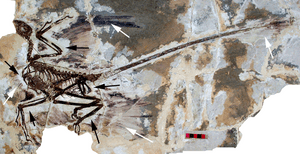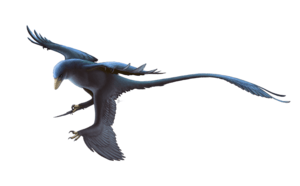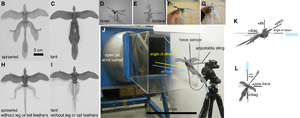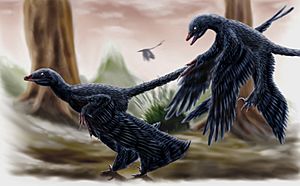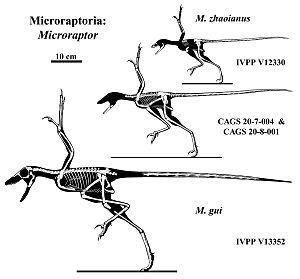Microraptor facts for kids
Quick facts for kids MicroraptorTemporal range: Lower Cretaceous
|
|
|---|---|
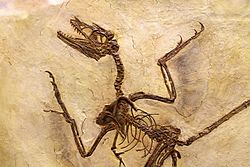 |
|
| Close-up of a cast | |
| Scientific classification | |
| Kingdom: | |
| Class: | |
| Subclass: | |
| Superorder: | |
| Order: | |
| Suborder: | |
| (unranked): | |
| Family: | |
| Genus: |
Microraptor
|

Microraptor was a small, feathered dinosaur. It was related to the famous Velociraptor. This amazing creature had flight feathers on all four of its limbs. It could likely glide and perhaps even fly!
Scientists have found about two dozen well-preserved fossils of Microraptor. These fossils were discovered in Liaoning, China. They come from rocks that are about 125 million years old. This makes them from the Lower Cretaceous period.
Adult Microraptor were quite small. They were only about 42 to 83 centimeters (1.4 to 2.7 feet) long. This makes Microraptor one of the smallest dinosaurs ever found.
Contents
What did Microraptor look like?
Microraptor was one of the smallest non-bird dinosaurs known. It was about 77 centimeters (2.5 feet) long. It weighed around 1 kilogram (2.2 pounds).
What made Microraptor special were its feathers and wings. It was one of the first non-bird dinosaurs found with clear feather and wing impressions. It had long flight feathers on its front arms and its back legs. This gave it four wings! Its body was covered in thick feathers. It also had a diamond-shaped fan of feathers on its tail. This tail fan might have helped it stay stable when flying.
Some scientists think Microraptor might have had a crest of feathers on its head. Bands of dark and light on some fossils suggest it had color patterns. Many scientists now believe it had shiny, iridescent black feathers.
What color was Microraptor?
In 2012, scientists studied a Microraptor fossil. They looked at tiny structures called melanosomes. These are like pigment cells that give color to feathers. By comparing them to modern birds, they learned about Microraptor's color.
The melanosomes showed that Microraptor likely had black, glossy feathers. These feathers would have shimmered with different colors, like a modern Common starling. This shiny look is called iridescence. Scientists think this shiny coat might have been used for communication. It could have helped Microraptor attract mates or show off.
How did Microraptor move and fly?
Did Microraptor fly?
Microraptor had four wings. One pair was on its front limbs, and another on its hind limbs. Its arm and hand feathers were 10 to 20 cm (4-8 inches) long. Its leg and foot feathers were 11 to 15 cm (4-6 inches) long. These were true flight feathers, just like those on modern birds.
Scientists first thought Microraptor was a glider. They believed it lived mostly in trees. Its hindwings might have made it hard to run on the ground. Some thought it might have parachuted from trees to catch prey. However, studies showed its wings were too small for safe parachuting from high up. It might have glided short distances between tree branches.
Later studies suggested Microraptor could do more than just glide. Some scientists believe it could fly under its own power. Its strong breastbone and special shoulder features point to this. While it might not have flown like modern birds, it was likely an active flyer. It could even launch itself into the air from the ground or by running up slopes.
How did its four wings work?
One idea is that Microraptor's four wings worked like a biplane. This means the front wings and back wings were on different levels. This setup would have helped it glide or fly. When gliding, it might have swooped down in a U-shape. Then it would lift up to land on another tree. The feathers on its legs and tail could have helped it steer and control its flight path.
Some scientists disagreed with the biplane idea. They thought the legs couldn't splay out enough for that. They suggested other ways the wings might have been held. However, other research supported the biplane idea. It showed that Microraptor's hip bones might have allowed its legs to spread out more than other dinosaurs.
How did Microraptor move on the ground?
The long feathers on Microraptor's hind legs would have made walking tricky. Its front wing feathers also got in the way. They were so long that they would drag on the ground if its arms were held normally. To avoid damaging its feathers, Microraptor likely had to keep its wings lifted up. This means it probably couldn't use its front claws easily for hunting or grabbing things.
What did Microraptor eat?
Scientists have found some amazing clues about Microraptor's diet. In one fossil, they found bones of a small mammal inside its stomach area. This mammal was about 8 centimeters (3 inches) long. It was similar to early climbing mammals.
Another fossil showed bird bones in its belly. This suggests Microraptor swallowed a tree-perching bird whole!
In 2013, researchers found fish scales in a Microraptor fossil. This was a big surprise! It showed that Microraptor didn't just hunt in trees. It also ate fish. Its front teeth were angled forward, which is common in fish-eating animals. This means Microraptor was an opportunistic hunter. It ate whatever prey was most common, whether in trees or near water.
Scientists also looked at Microraptor's eyes. They thought it might have hunted at night. But the discovery of its shiny feathers made this less likely. Most modern birds with iridescent feathers are active during the day.
Images for kids
-
Specimen at the Beijing Museum of Natural History
-
Size of Microraptor (1) compared with other dromaeosaurs
-
William Beebe's hypothetical "Tetrapteryx" with four wings, 1915
See also
 In Spanish: Microraptor para niños
In Spanish: Microraptor para niños


